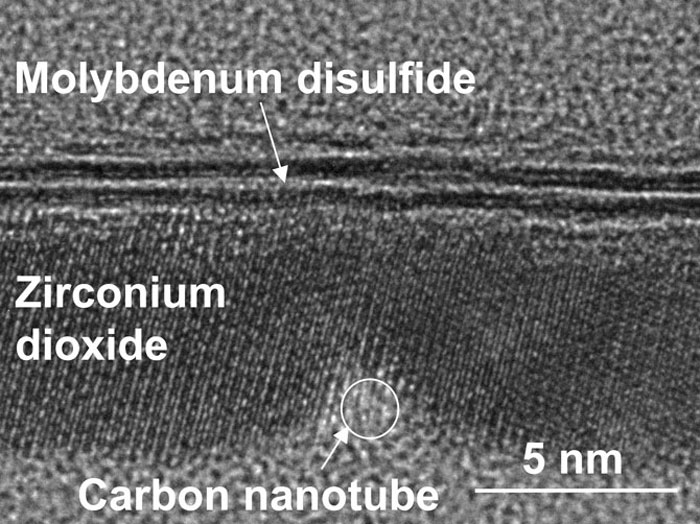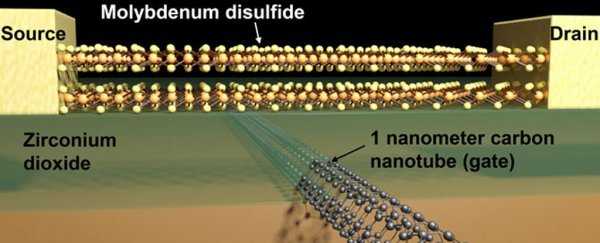Scientists have succeeded in creating the world's smallest transistor, producing a switch with a working 1-nanometre gate. If you want to know how incredibly tiny that is, a human hair is around 80,000 to 100,000 nanometres wide.
Unlike regular transistors, the researchers' new prototype isn't made out of silicon – and the smaller size means we can still improve performance in integrated circuits by populating them with greater amounts of incredibly small components.
And it could help us keep Moore's Law alive too.
Named after Intel co-founder Gordon Moore, Moore's Law predicts that the amount of transistors in an integrated circuit will double approximately every two years, enabling more complex and powerful computer processors.
Unfortunately, transistors have already gotten so small, we're running out of ways to make them smaller. But now, thanks to a team of researchers at the University of California, Berkeley, we've gotten past the 5-nanometre threshold that was previously considered to be the peak of transistor miniaturisation.
"We made the smallest transistor reported to date," says researcher Ali Javey, the head of Berkeley Lab's Materials Science Division. "We demonstrated a 1-nanometre-gate transistor, showing that with the choice of proper materials, there is a lot more room to shrink our electronics."
Javey's team was able to hit the 1-nanometre limit by using carbon nanotubes with a material called molybdenum disulphide (MoS2), which is sometimes used as an engine lubricant.
In conventional (read: bigger) transistors, silicon is an ideal material, because electrons flowing through the circuitry encounter low amounts of resistance.
With MoS2, they encounter greater resistance, but that slow-down effect is actually beneficial when the transistors become extremely small, because it helps to control electron behaviour.
One of the reasons 5-nanometre transistors were previously considered to be the theoretical limit is because once you go smaller than that with silicon, a phenomenon called quantum tunnelling occurs, where electrons start leaping from one transistor to another, making signals go haywire.
"This means we can't turn off the transistors," says lead researcher Sujay Desai. "The electrons are out of control."
But with MoS2 in place of silicon, and effectively putting the brakes on electrons, the signals can once more be controlled.
In testing, the researchers' prototype device – which combines MoS2 with a 1-nanometre-wide carbon nanotube – showed that the transistor effectively controlled the flow of electrons.
One of the reasons it's such a victory – aside from the obvious benefit of enabling better computer performance in computers – is that nobody knew this could be done before.
"The semiconductor industry has long assumed that any gate below 5 nanometres wouldn't work, so anything below that was not even considered," says Desai.
"This research shows that sub–5-nanometer gates should not be discounted… By changing the material from silicon to MoS2, we can make a transistor with a gate that is just 1 nanometer in length, and operate it like a switch."
 Cross section of the transistor. Credit: Qingxiao Wang/UT Dallas
Cross section of the transistor. Credit: Qingxiao Wang/UT Dallas
Despite their success, the team acknowledges that there's a long way to go before we'll be using 1-nanometre transistors in our computers and mobile devices. Now that we know such small switches can work, we need to figure out how to reliably manufacture them at scale – and work on optimising the technology further.
"This work demonstrated the shortest transistor ever," says Javey. "However, it's a proof of concept. We have not yet packed these transistors onto a chip, and we haven't done this billions of times over."
Still, if we can address those difficulties, the findings here mean the performance of technology at the circuitry level will continue to advance in the near future – and indeed keep pace with the timeline Gordon Moore predicted several decades ago.
"[T]his work is important to show that we are no longer limited to a 5-nanometre gate for our transistors," says Javey. "Moore's Law can continue a while longer by proper engineering of the semiconductor material and device architecture."
The findings are reported in Science.
